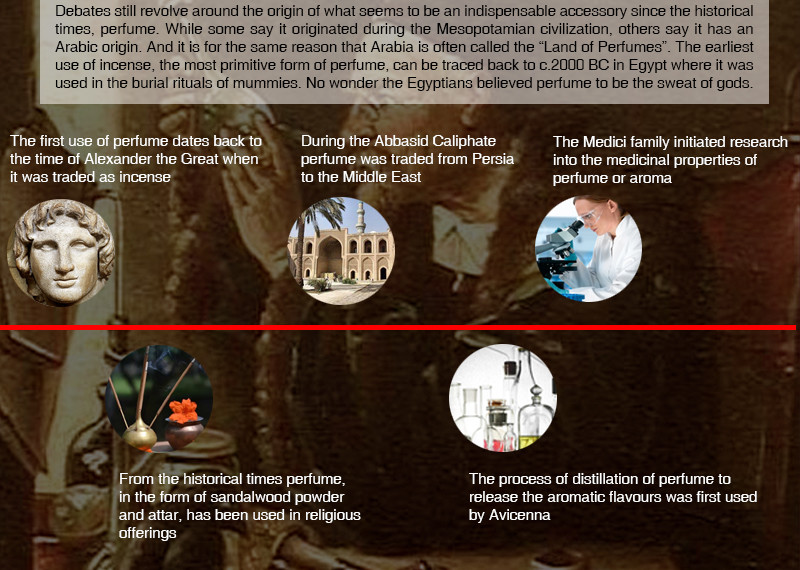The Evolution of Perfume
Debates still revolve around the origin of what seems to be an indispensable accessory since the historical times, perfume. While some say it originated during the Mesopotamian civilization, others say it has an Arabic origin. And it is for the same reason that Arabia is often called the “Land of Perfumes”. The earliest use of incense, the most primitive form of perfume, can be traced back to c.2000 BC in Egypt where it was used in the burial rituals of mummies. No wonder the Egyptians believed perfume to be the sweat of gods.
- The first use of perfume (The first use of perfume dates back to the time of Alexander the Great when it was traded as incense)
The very first use of perfume dates back to the time of Alexander the Great, where a passage mentions a “chest of perfumes” accompanying the great warrior. The perfume was traded as incense that again finds mention in Genesis. Joseph had been traded by his brother to merchants who carried “spicery, balm and myrrh”. There are indications of the use of perfume in the form of incense by Cleopatro as well.
- Religious uses (from the historical times perfume, in the form of sandalwood powder and attar, has been used in religious offerings.)
Sandalwood has aromatic properties and it has always been associated with gods and worship. There is a mention of perfumes in the great Hindu epic, Ramayana, as well, where the nobles have been said to spray themselves with sandalwood aroma. There are mentions about perfumed powders carried by the warriors. ‘Attar’, essential oil has been long associated with religious works and worships. The walls of Mecca were said to be sprayed with perfumes.
- The Book of Perfume Chemistry and Distillation (during the Abbasid Caliphate perfume was traded from Persia to the Middle East)
Most of what we call early Arab perfumes has come down from those mentioned in the book y Yakub al-Kindi, The Book of Perfume Chemistry and Distillation. Right from the seventh century, when Persia belonged to the Abbasid Caliphate, aroma or the making of perfume was considered to be a form of art. Later, trading of perfumes with the Asian countries like India and China brought about raw materials to the countries which again triggered the art of perfume-making. In fact, Baghdad was the centre of perfume-trading in the seventh century. There were nearly 50 shops for perfume in the country. The concept of perfume was introduced into the Christian world by the crusaders who returned from Arab. There is mention of perfume in Shakespeare’s Macbeth where Lady Macbeth speaks of “All the perfumes of Arabia”.
- Introduction of perfume into the labs (the process of distillation of perfume to release the aromatic flavours was first used by Avicenna)
The process of distillation of perfume was initiated by the Persians. Avicenna used principles of chemistry to preserve the aroma of flowers by the process of distillation. By the end of the 13th century, Persia had become a leading producer of raw materials for perfume. These raw materials were then sent to Venice through export from where these were traded with the Middle East.
- Research into the properties of aroma (the Medici family initiated research into the medicinal properties of perfume or aroma)
The Medici family from Florence initiated research into the medicinal values of aromatic plants. Alembics were collected by the Dukes of Ferrara as well as the Medici to prepare aromatic compositions of varied types, catering to the tastes of the mercantile class. The Italian aristocrats too involved themselves in the art of perfume making and perfume trade.

